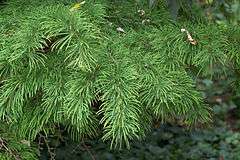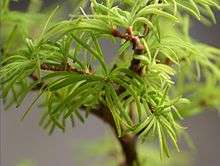Pseudolarix
| Pseudolarix Temporal range: 49–0 Ma Early Eocene to recent | |
|---|---|
 | |
| Scientific classification | |
| Kingdom: | Plantae |
| Division: | Pinophyta |
| Class: | Pinopsida |
| Order: | Pinales |
| Family: | Pinaceae |
| Genus: | Pseudolarix Gordon |
| Species: | P. amabilis |
| Binomial name | |
| Pseudolarix amabilis (J.Nelson) Rehder | |
| Synonyms | |
| |
Pseudolarix is a monotypic genus of conifer in the family Pinaceae. The sole species, Pseudolarix amabilis, is commonly known as the golden larch, though it is not a true larch (Larix), being more closely related to Keteleeria, Abies and Cedrus. It is native to eastern China, occurring in small areas in the mountains of southern Anhui, Zhejiang, Fujian, Jiangxi, Hunan, Hubei and eastern Sichuan, at altitudes of 100–1,500 m (328–4,921 ft). Golden larch is sometimes known under an old scientific name Pseudolarix kaempferi, but this may cause confusion with Larix kaempferi, the Japanese larch.
Growth

It is a deciduous coniferous tree reaching 30–40 m (98–131 ft) tall, with a broad conic crown. The shoots are dimorphic, with long shoots and short shoots similar to a larch, though the short shoots are not so markedly short, lengthening about 5 mm annually. The leaves are bright green, 3–6 cm long and 2–3 mm broad, with two glaucous stomatal bands on the underside; they turn a brilliant golden yellow before falling in the autumn, hence the common name. The leaves are arranged spirally, widely spaced on long shoots, and in a dense whorl on the short shoots.
The cones are distinctive, superficially resembling a small globe artichoke, 4–7 cm long and 4–6 cm broad, with pointed triangular scales; they mature about 7 months after pollination, when (like fir and cedar cones) they disintegrate to release the winged seeds. The male cones, as in Keteleeria, are produced in umbels of several together in one bud.
Characteristics
Golden larch is a very attractive ornamental tree for parks and large gardens, commonly referenced as the "Koosh Ball tree." Unlike the true larches, it is very tolerant of summer heat and humidity, growing very successfully in the southeastern United States where most larches and firs do not succeed. In Europe growth is most successful in the Mediterranean region with notable specimens in northern Italy; further north in the United Kingdom it will grow, but only very slowly due to the cooler summers.
This plant has gained the Royal Horticultural Society's Award of Garden Merit.[1]
Traditional medicine
Golden Larch is one of the 50 fundamental herbs used in Chinese herbology, where it is called jīn qián sōng (Chinese: 金钱松). Pseudolarix amabilis is used in traditional Chinese medicine as dermatologic antifungal remedy.

 Closeup of bark.
Closeup of bark.
See also
- Chinese herbology 50 fundamental herbs
References
- ↑ "Pseudolarix amabilis AGM". Royal Horticultural Society. Retrieved July 14, 2012.
Further reading
- Conifer Specialist Group (2000). "Pseudolarix amabilis". IUCN Red List of Threatened Species. Version 2006. International Union for Conservation of Nature. Retrieved 12 May 2006. Database entry includes justification for why this species is listed as data deficient
External links
| Wikimedia Commons has media related to Pseudolarix. |
| Wikispecies has information related to: Pseudolarix |
- Arboretum de Villardebelle - photos of cones
- Gymnosperm Database
- Pseudolarix in the Flora of China
- Article in Harvard University Bulletin of Popular Information (1919)
